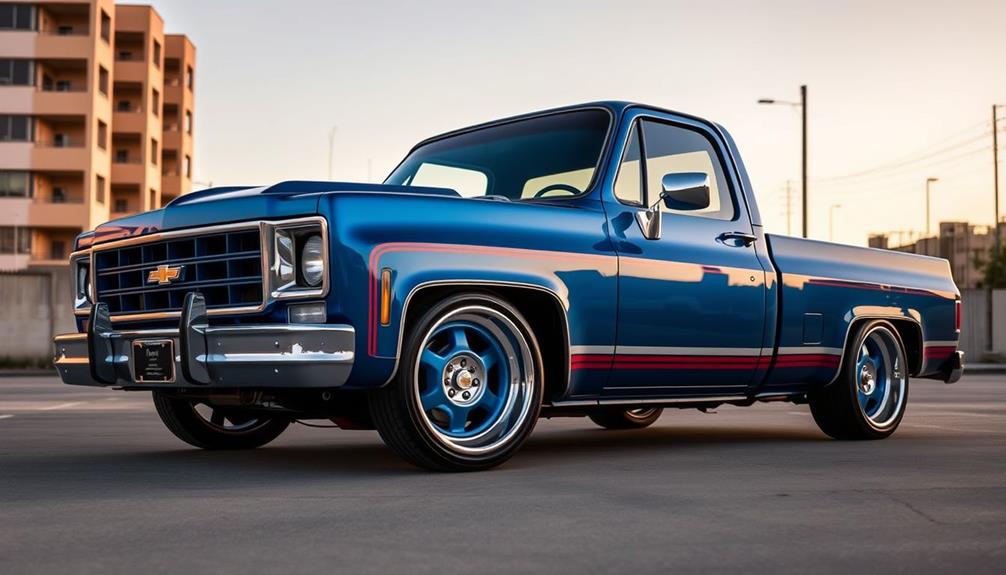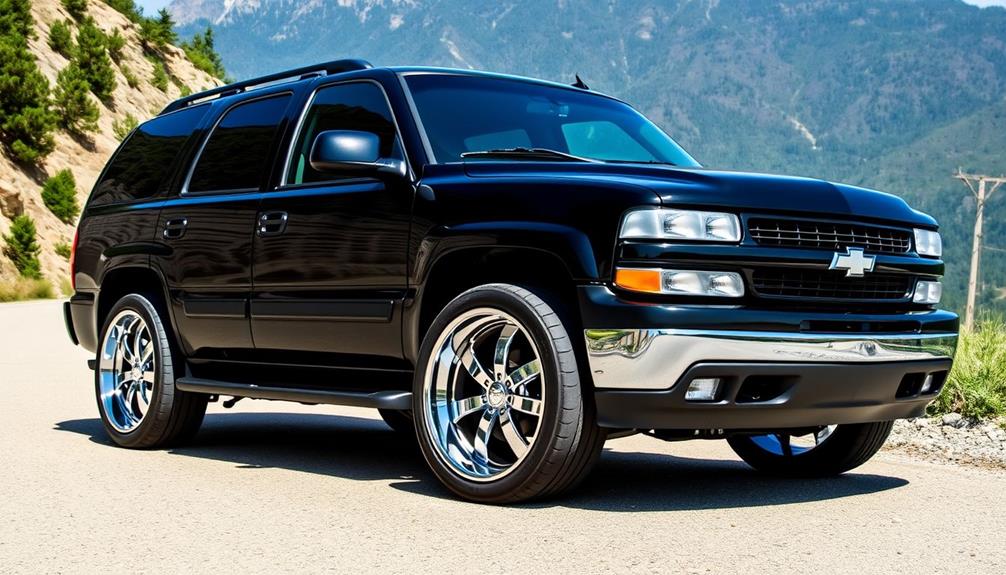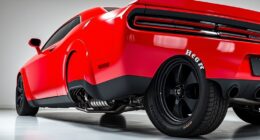Tuning your 1979 Chevrolet C10 can elevate it from a classic truck to a high-performance beast. Start with a powerful Edelbrock 350 engine swap for increased horsepower and torque. Upgrade your transmission to a Gearstar 4L60E for smoother shifts. Enhance handling with a CPP trailing-arm kit and Fox coilovers. Don’t forget to boost safety with a Wilwood 14-inch brake conversion. Inside, you can improve comfort with better insulation and upgraded audio systems. For a stunning visual appeal, consider custom paint and modern wheels. Stick around to discover even more tips and tricks to maximize your classic truck’s performance. Looking into aftermarket exhaust systems and headers can also help to improve airflow and increase power output. Additionally, investing in high-performance spark plugs and ignition systems can further enhance the overall performance of your classic truck. With the right combination of upgrades and tuning, you can truly maximize the potential of your classic truck performance tuning and turn heads wherever you go.
Key Takeaways
- Upgrade to an Edelbrock-equipped 350 engine swap for increased horsepower and torque, enhancing overall performance.
- Install a Gearstar 4L60E transmission for improved drivability and responsive shifting.
- Enhance braking with a Wilwood/CPP big disc brake conversion and six-piston calipers for superior stopping power.
- Modernize your suspension with Fox coilovers and a CPP trailing-arm kit for better handling and ride comfort.
- Consider a standalone Holley EFI system for precise tuning and optimal engine performance.
Understanding the Chevy C10 Legacy
The Chevrolet C10 stands as a symbol of American automotive heritage, embodying ruggedness and adaptability. If you're a classic truck enthusiast, you likely appreciate how the Chevy C10 Big, particularly the 1979 model, showcases a perfect blend of nostalgic design and enhanced capabilities.
Produced between 1960 and 1998, the C10 is celebrated for its robust construction, making it a favorite among those who value durability and versatility in a classic truck.
The 1979 Chevy C10 Big 10 represents a significant chapter in the C10 legacy, merging classic aesthetics with improved performance features. As you explore the world of C10s, you'll find that customization and restoration play essential roles in maintaining their appeal.
The vast aftermarket parts network guarantees you can easily find upgrades, allowing you to personalize your truck to fit your style and needs.
Your journey with the C10 doesn't just end with ownership; it's a celebration of community and shared passion. Publications like Custom Classic Trucks highlight restoration projects, reinforcing the timeless allure of the Chevy C10 Big and its place in automotive history.
Performance Enhancements Overview

Upgrading your 1979 Chevrolet C10 not only enhances its performance but also transforms your driving experience.
With the right performance enhancements, you can greatly elevate your truck's capabilities, making it a true high-performance beast.
Consider these key upgrades:
- Gearstar 4L60E transmission for improved drivability and performance.
- Howell Developments TBI kit to optimize fuel efficiency and engine performance.
- Wilwood/CPP 14-inch big disc brake conversion for superior stopping power and safety.
- CPP trailing-arm kit tested over 5,200 miles for enhanced ride quality and handling.
Engine and Transmission Upgrades

Transforming your 1979 Chevrolet C10's engine and transmission can greatly enhance its performance and driving experience.
Start with engine upgrades by replacing the stock powertrain with a built Edelbrock-equipped 350 engine. This swap notably boosts horsepower and torque, allowing your truck to perform at an entirely new level.
To complement this, think about adding a Howell Developments TBI (Throttle Body Injection) kit. This upgrade not only improves fuel efficiency but also makes your engine more responsive, giving you that extra edge on the road.
For transmission upgrades, swapping in a Gearstar 4L60E transmission enhances drivability with smoother shifting and improved acceleration over the stock version.
If you're looking for better gearing options and highway cruising efficiency, the Bowtie Overdrives 700-R4 transmission is an excellent choice, combining performance with comfort.
These upgrades transform your C10 into a high-performance beast, ensuring it delivers a thrilling driving experience.
Don't forget to think about your braking system; incorporating a Wilwood/CPP 14-inch big disc brake conversion will provide superior stopping power, enhancing safety during those high-performance drives.
Suspension Modifications for Handling

Enhancing your 1979 Chevrolet C10's performance doesn't stop with the engine and transmission; suspension modifications play a key role in improving handling and ride quality.
By focusing on the suspension, you can transform your truck into a high-performance beast that can tackle corners with confidence.
Here are some vital suspension modifications to evaluate:
- Upgrade to a CPP trailing-arm kit for better suspension geometry and stability.
- Install Fox coilovers for improved ride comfort and cornering control.
- Add a front sway bar to minimize body roll during aggressive driving.
- Regularly maintain and adjust suspension components for peak performance.
These modifications not only enhance handling but also contribute to a more engaging driving experience.
A modernized suspension setup lowers your center of gravity, which effectively reduces body roll and improves traction.
Remember, the right suspension modifications can make all the difference in how your C10 performs on the road.
With the right upgrades, you'll enjoy a smoother ride and increased responsiveness, making your classic truck feel more like a modern performance vehicle.
Brake System Upgrades

When it comes to maximizing the performance of your 1979 Chevrolet C10, a robust brake system is vital. Upgrading to a Wilwood/CPP 14-inch big disc brake conversion considerably enhances your stopping power, giving you a more responsive and reliable braking experience. With six-piston calipers, you'll notice improved efficiency and reduced stopping distances, especially during high-performance driving.
To accommodate the increased fluid requirements, it's often necessary to install a new master cylinder, guaranteeing proper brake function. The larger rotors and calipers also enhance heat dissipation, reducing the risk of brake fade during prolonged braking. Regular maintenance of these brake system upgrades, like checking fluid levels and inspecting components for wear, is essential for peak performance and safety.
Here's a quick comparison of brake system upgrades:
| Upgrade Type | Benefits | Notes |
|---|---|---|
| Big Disc Conversion | Enhanced stopping power | Requires larger wheels |
| Six-Piston Calipers | Improved braking efficiency | Reduces stopping distance |
| New Master Cylinder | Guarantees proper fluid flow | Necessary for upgrades |
| Larger Rotors | Better heat dissipation | Prevents brake fade |
| Regular Maintenance | Maintains peak performance | Essential for safety |
Interior Comfort and Technology

Improving the interior comfort and technology of your 1979 Chevrolet C10 can make a world of difference in your driving experience. By making a few key upgrades, you'll transform your classic truck into a more enjoyable and functional ride.
Additionally, guaranteeing you have the right cold medications overview before starting on long drives can help you stay alert and comfortable.
- Dynamat Xtreme installation for enhanced insulation and reduced noise levels.
- Upgraded HVAC performance for ideal temperature control in any weather.
- Brothers direct-fit power window mechanisms for easier window operation.
- 6×9 Powerbass speakers strategically placed for high-quality audio.
These enhancements focus on both interior comfort and advanced technology, allowing you to enjoy your drive like never before.
Installing Dynamat Xtreme will greatly reduce road noise, letting you appreciate the new sound system without distractions.
The improved HVAC system guarantees you stay comfortable whether it's sweltering or chilly outside.
With power windows, you'll enjoy the convenience of modern technology while maintaining a classic feel.
Aesthetic Customizations

A variety of aesthetic customizations can transform your 1979 Chevrolet C10 into a head-turning classic.
Start with a striking custom grille from LMC Truck, which not only modernizes your truck's front-end appearance but also adds a unique flair. Upgrading to a premium paint job, like House of Kolors Honey Gold, considerably elevates the visual appeal, showcasing the classic lines of your truck.
For improved nighttime visibility and an updated look, consider installing JW Speaker LED headlights. They enhance both aesthetics and safety, making your classic truck stand out on the road.
To add a refined touch, polished chrome accents through an exterior billet package can provide an elegant finish that complements your truck's overall design.
Lastly, installing custom 20-inch U.S. Mags CTEN wheels paired with Nitto NT555 G2 tires not only enhances your truck's stance but also improves its road presence and performance.
With these aesthetic customizations, your 1979 Chevrolet C10 won't only maintain its classic charm but also turn heads wherever you go. Embrace these upgrades and watch your classic truck transform into a stunning masterpiece.
Maintenance and Care Tips

Maintaining your 1979 Chevrolet C10 is vital for preserving its classic charm and ensuring peak performance. By following a few key maintenance tips, you can keep your truck running smoothly and looking great for years to come.
- Regularly inspect and address any rust damage, focusing on moisture-prone areas.
- Clean the interior of doors thoroughly before installing insulation to prevent moisture-related issues.
- Use compressed air to dry surfaces before applying insulation or components to avoid trapping moisture.
- Implement routine maintenance checks on essential components like brakes and suspension.
Storing your C10 in a protective environment is another important aspect of maintenance. Doing so minimizes wear from outdoor elements, greatly extending its lifespan and maintaining its overall condition.
By taking these steps, you'll not only keep your truck in top shape but also enhance its value and reliability. Remember, a well-maintained vehicle is a joy to drive and showcases your dedication to preserving this classic gem.
Future Tuning and Upgrades

With your 1979 Chevrolet C10 well-maintained, you can now explore exciting future tuning and upgrades that will elevate its performance and driving experience.
One of the most notable changes you can make is swapping in a modern LS engine. With the right modifications, you could push horsepower beyond 500 while also enhancing fuel efficiency.
Upgrading to a standalone engine management system like Holley EFI will give you precise tuning capabilities, allowing you to optimize your truck's performance.
To further boost power, consider installing performance headers and a custom exhaust system for improved exhaust flow and an aggressive sound profile. An aftermarket air intake system will also enhance airflow to the engine, improving acceleration and overall performance.
Don't overlook the importance of suspension upgrades.
Installing adjustable coilovers and performance sway bars can greatly enhance your truck's handling and ride quality, making it more responsive during aggressive driving.
These future tuning options will transform your classic C10 into a high-performance beast, ready to tackle any road with power and style.
Frequently Asked Questions
How Rare Is a Chevy Big 10?
The Chevy Big 10's rarity stems from its limited production, with about 20,000 units made. As more owners customize their trucks, the number of original models decreases, making yours even more special if you own one.
Is the Chevy C10 a Classic?
When you think of classic trucks, the Chevy C10 stands tall like a timeless oak. Its iconic design and rich history definitely earn it a classic status. You'll appreciate its enduring charm and performance potential.
How Fast Does a Chevy C10 Go?
Your Chevy C10 can reach top speeds between 90 and 100 mph, depending on its engine and modifications. Tune it right, and you'll experience enhanced acceleration and performance, making every drive more exhilarating.
How Much Horsepower Does a 1980 Chevy C10 Have?
Ever wonder how much power a 1980 Chevy C10 has? It typically features a 305 V8 with around 140 horsepower or an optional 350 V8 offering about 170 horsepower, depending on your choice.
Conclusion
In transforming your 1979 Chevy C10, you're not just enhancing performance; you're reviving a classic that turns heads like a muscle car at a modern car show. With the right upgrades, your truck can handle like a dream and make the streets feel like a racetrack. Remember, it's all about balancing power and style while keeping that vintage vibe alive. So, buckle up and enjoy the ride—you've got a beast worth showing off!










